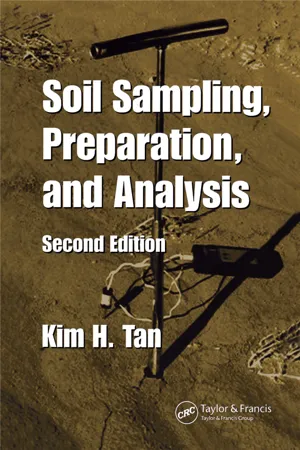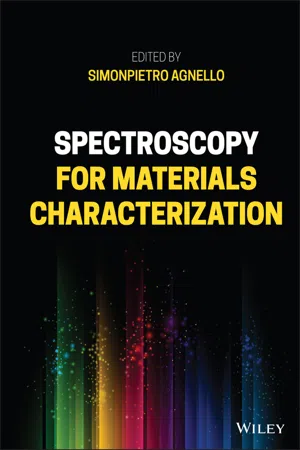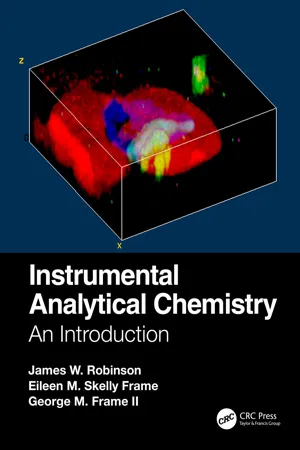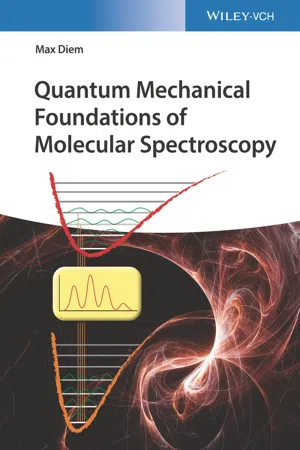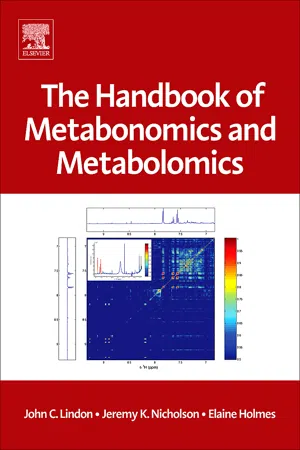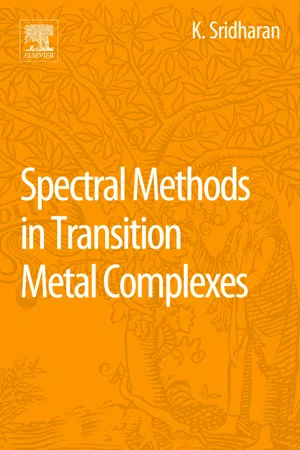Chemistry
NMR Spectroscopy
Nuclear Magnetic Resonance (NMR) spectroscopy is a powerful analytical technique used to study the structure and dynamics of molecules. It relies on the interaction between the magnetic properties of atomic nuclei and an external magnetic field. By measuring the resonance frequencies of nuclei in a sample, NMR spectroscopy provides valuable information about molecular composition, connectivity, and environment.
Written by Perlego with AI-assistance
Related key terms
Related key terms
1 of 4
Related key terms
1 of 3
11 Key excerpts on "NMR Spectroscopy"
- eBook - ePub
- Kim H. Tan(Author)
- 2005(Publication Date)
- CRC Press(Publisher)
Chapter 20 Nuclear Magnetic Resonance SpectroscopyNuclear Magnetic Resonance (NMR) spectroscopy is another analytical technique, which is also fairly new. Following its discovery in 1946 and first recorded applications in 1973 (Willard et al., 1974; Pfeffer and Gerasimowicz, 1989), improvements in instrumentation, and advancement in techniques were so rapid that today it is considered a very powerful and important analytical method. Because of the use of radiowaves, analysis by NMR Spectroscopy was in the beginning discredited for its low speed and low sensitivity. However, with the development of a Fourier transform NMR spectrometer employing high-field super-conducting electromagnets, the speed and sensitivity of analysis have been improved significantly. Today, this method continues to attract an ever-increasing discipline of sciences, from chemistry, physics, biochemical, medical to agricultural and soil sciences. Its counterpart in medical science, using the same NMR principles, is known under the name MRI, for magnetic resonance imaging. As indicated before, the only difference from NMR is that MRI produces images of the internal organs of the human body, important for diagnosis of pathological disorders.As is the case with SEM, NMR Spectroscopy is also a nondestructive or noninvasive method of analysis. However, the high cost of an NMR spectrometer is for many scientists a major drawback, and without sizeable research grant funding at their disposal, only the most affluent laboratories can afford the luxury of possessing one. Nevertheless, the less fortunate can acquire the use of them through personal relations or cooperative research.20.1 Principles of NMR
The basics of NMR discussed in many of the books and articles are far from simple, and if not confusing, often defy the logic of most common scientists. Therefore, the present author has tried ‘translating’ - eBook - ePub
- Simonpietro Agnello, Simonpietro Agnello(Authors)
- 2021(Publication Date)
- Wiley(Publisher)
10 Nuclear Magnetic Resonance Spectroscopy Alberto Spinella1 and Pellegrino Conte2 1 Advanced Technologies Network Center (ATeN Center), University of Palermo, Palermo, Italy 2 Department of Agriculture, Food and Forestry Sciences, University of Palermo, Palermo, Italy10.1 Introduction
Nuclear magnetic resonance (NMR) spectroscopy is a powerful technique used in many fields from basic to applied sciences in order to characterize both molecular and supramolecular structures of organic and inorganic compounds. Among the various spectroscopic techniques, NMR is one of the most versatile due to its ability to unveil three‐dimensionality of molecular systems in each of the three different physical states (liquid, solid, and gas) and regardless of sample crystallinity.Purcell, Torrey, and Pound at Harvard University [1] and Bloch, Hansen, and Packard at Stanford University [2] performed the first NMR experiments in condensed matter independently of each other in 1945. In particular, they obtained NMR signals from protons of paraffin wax and liquid water, respectively. However, since those pioneering days, NMR has become a well‐established spectroscopic technique. In particular, both liquid and solid‐state NMR spectroscopies are largely exploited for molecular structure determination and dynamics in several chemistry fields (e.g. protein chemistry, materials science, cultural heritage, food science, and so on), while NMR imaging is recognized as a very powerful tool in modern medicine in order to monitor biological tissues and living functions.In the following, an overview of the basic principles of NMR Spectroscopy and the main topics that may be useful to researches of different areas will be given. A detailed and in‐depth introduction to NMR Spectroscopy can be found in several textbooks [3 –5 ].10.2 NMR General Concepts
10.2.1 Nuclear Spin and Magnetic Moment
All elementary particles have an intrinsic property referred to as spin. This property has been introduced to explain the deflection of the elementary particles when they pass through an inhomogeneous magnetic field. In fact, according to the experiment by Stern and Gerlach, an elementary particle, such as an electron, being a moving electric charge, should behave like a small linear magnet when crossing a magnetic field gradient. Therefore, a continuous distribution should be revealed on the surface of a detector. Conversely, the image obtained by elementary particles crossing the magnetic field gradient is an ensemble of discrete points of accumulation. This suggests that all the elementary particles have an intrinsic spin angular momentum which can have only discrete values given by: - eBook - ePub
Instrumental Analytical Chemistry
An Introduction
- James W. Robinson, Eileen M. Skelly Frame, George M. Frame II(Authors)
- 2021(Publication Date)
- CRC Press(Publisher)
Magnetic Resonance Spectroscopy 5 DOI: 10.1201/b21879-5 5.1 Nuclear Magnetic Resonance Spectroscopy: Introduction NMR Spectroscopy is one of the most powerful techniques available for studying the structure of molecules. The NMR technique has developed very rapidly since the first commercial instrument, a Varian HR-30, was installed in 1952 at the Humble Oil Company in Baytown, Texas. These early instruments with small magnets were useful for studying protons (1 H) in organic compounds, but only neat liquids or solutions with a high concentration of analyte. That has now changed—much more powerful magnets are available. NMR instruments and experimental methods are now available that permit the determination of the 3D structure of proteins as large as 900,000 Da. “Magic angle” NMR instruments are commercially available for studying solids such as polymers, and 13 C, 19 F, 31 P, 29 Si, and other nuclei are measured routinely. NMR imaging techniques under the name magnetic resonance imaging (MRI) are in widespread use in noninvasive diagnosis of cancer and other medical problems. NMR instruments coupled to liquid chromatographs and mass spectrometers for separation and characterization of unknowns are commercially available. Resolution and sensitivity have both increased; detection and identification of ppm concentrations of substances with NMR is easily achieved in modern instruments and detection limits are approaching nanogram levels. NMR detection is being coupled with liquid chromatographic separation in HPLC-NMR instruments for identification of components of complex mixtures in the flowing eluant from the chromatograph, and NMR is now used as a nondestructive detector combined with mass spectrometry and chromatography in HPLC-NMR-MS instruments, an extremely powerful tool for organic compound separation and identification - eBook - ePub
Problems of Instrumental Analytical Chemistry
A Hands-On Guide
- JM Andrade-Garda, A Carlosena-Zubieta;MP Gómez-Carracedo;MA Maestro-Saavedra;MC Prieto-BlancoRM Soto-Ferreiro(Authors)
- 2017(Publication Date)
- WSPC (EUROPE)(Publisher)
CHAPTER 7
NUCLEAR MAGNETIC RESONANCE AND MASS SPECTROMETRIES
Miguel Angel Maestro-Saavedra
OBJECTIVES AND SCOPE
The main objective of this chapter is to present students a concise, basic and practical overview of two powerful techniques for the structural characterization of organic and inorganic chemical structures; namely, nuclear magnetic resonance (NMR) spectrometry and mass spectrometry (MS). Explanations range from essential background to descriptions of key concepts to some practical applications. A selected collection of exercises show how these key concepts are applied and how a structural elucidation from the NMR and MS spectra can be obtained.To explain how to interpret a mass spectrum is anything but simple because there are no fixed rules which can be followed. Therefore, in this chapter, it is attempted to present the very basics of the MS technique and give some general guidances, along with some examples.PART A: NUCLEAR MAGNETIC RESONANCE SPECTROMETRY
1.INTRODUCTION TO NUCLEAR MAGNETIC RESONANCE
Nuclear magnetic resonance (NMR) spectrometry is a fundamental tool for the structural determination of organic and inorganic molecules. It employs low-energy radiation, in the radio frequencies (RF) region, in order to gather information on the structure of alkyl groups and other hydrogen-containing elements. Then, the presence of functional groups in the molecule is deduced.1.1.Basic principles
Many atomic nuclei behave as if they were spinning around themselves (nuclear spin) . When a charged particle (nucleus) moves or rotates, it creates a magnetic field. The orientation of H is random in the space until the nuclei is inserted in an external magnetic field Ho, which causes H to get aligned with H 0 . This can occur in two forms: aligning the magnetic moment H in the direction of the H 0 field (energetically favorable) or otherwise, counterclockwise to H 0 (it requires the input of energy as it is energetically unfavorable). The two possibilities are referred to as the nuclear spin states α and β - eBook - ePub
Handbook of Analytical Techniques for Forensic Samples
Current and Emerging Developments
- Deepak Rawtani, Gaurav Pandey, Maithri Tharmavaram, Chaudhery Mustansar Hussain(Authors)
- 2020(Publication Date)
- Elsevier(Publisher)
Chapter 6: NMR Spectroscopy for forensic samples Abstract Forensic science is largely based on the analysis of evidence found at the crime scene. The characterization of evidence over the years has been characterized by various techniques. The most crucial aspect of evidence characterization is the accurate determination of its molecular structure. Nuclear magnetic resonance is one such technique that can determine the molecular structure of either a solid or a liquid sample. NMR is based on the analysis of the resonant magnetic signals emitted by the element in the presence of a strong external magnetic field. Every element has its own characteristic magnetic moment and can therefore be detected with the help of a complex instrumental setup. NMR has several advantages such as sample reusability even after testing, high resolution, and accurate structure determination. Currently, NMR has been used in forensic science to determine the structure of body fluids such as drug analysis, postmortem changes, explosive detection, xenobiotic examination, identification of body fluids, and identification of counterfeit products. In this chapter, the principle, workings, and instrumentation of NMR will be discussed. Also, the applications of NMR in different forensic applications will be discussed. Keywords Nuclear magnetic resonance; Drug analysis; Body fluids; Postmortem changes; Forensic science 1: Introduction Forensic science is largely based on the analysis of evidence found at a crime scene. The analysis of such evidence usually involves determining its structure, composition, and behavior (Pandey et al., 2017 ; Rawtani et al., 2019). One such technique that provides direct structural determination without any sample preparation is nuclear magnetic resonance (NMR) spectroscopy. NMR is a technique in that the characteristic electromagnetic signal produced by the nuclei of a molecule under high magnetic fields is detected - Max Diem(Author)
- 2021(Publication Date)
- Wiley-VCH(Publisher)
8 Nuclear Magnetic Resonance (NMR) Spectroscopy 8.1 General Remarks There are two major spectroscopic techniques that are based on the observation of transitions due to reorientation of spins in a magnetic field when exposed to electromagnetic radiation. These are electron paramagnetic resonance (EPR) and nuclear magnetic resonance (NMR) spectroscopies. In the former, the transitions are between energy states that an unpaired electron spin experiences in an external magnetic field. Some principles of the electron spin were introduced in the previous chapter. NMR Spectroscopy, on the other hand, is due to nuclear spin energy states that have not yet been introduced in previous discussions. Whereas EPR requires the presence of a radical molecule or ion (i.e. one with an unpaired electron), NMR is observed for any atom with a nonzero nuclear spin and has been developed mostly for 1 H and 13 C atoms. One can safely say that no spectroscopic method used in chemical and biochemical research has seen as explosive a growth over the past five decades as has NMR Spectroscopy that has become a cornerstone for researchers for identification of molecules and to establish molecular structure in solution and in the solid state. A major reason for this growth was the introduction of pulse Fourier transform (FT) methodology in the 1970s (to be discussed in Appendix 4) over continuous excitation that was common before that time. The advent of FT methodology itself was the result of the availability of low cost and dedicated instrument control computers and software to perform the FT rapidly. One other advantage of pulse FT methodology is the ability to program pulse sequences that excite specific aspects of the magnetization of the sample that lead to several new forms of spin interactions that reveal structural details not available in continuous excitation- eBook - ePub
- John C. Lindon, Jeremy K. Nicholson, Elaine Holmes(Authors)
- 2011(Publication Date)
- Elsevier Science(Publisher)
Chapter 3 NMR Spectroscopy Techniques for Application to MetabonomicsAlfred Ross, Goetz Schlotterbeck, Frank Dieterle, Hans Senn Pharma Research, F. Hoffman La-Roche AG, Basel Switzerland3.1. Introduction
Since its discovery in the 1940s, N uclear M agnetic R esonance (NMR) Spectroscopy has become a powerful, interdisciplinary method. A brief historical review would reveal as many as nine Nobel Prize laureates since the time when Isador I. Rabi developed resonance methods for recording the magnetic properties of atomic nuclei and was awarded the Nobel prize in physics (1944). The NMR phenomenon was soon later demonstrated for protons. After years of continuous development, Fourier Transform (FT) NMR entered the scene in the 1960s, followed by the evaluation of non-invasive preclinical and medical imaging in the early 1980s. At the same time, three-dimensional (3D) structure elucidation of proteins at atomic resolution in aqueous environment was developed [1 ]. This breakthrough was made possible also by the availability of superconducting materials and stable and robust electronic equipments.NMR has since been used in an almost unlimited variety of ways in physics, chemistry and biology. For the investigation of biological systems it is convenient to distinguish between three types of applications [2 ]: (1) to study structure and function of macromolecules, (2) to study metabolism, and (3) to obtain in vivo images of anatomical structure and functional (physiological) states.The use of 1 H NMR for metabolic studies was described as early as 1977 when it was shown that 1 H signals could be observed from a range of compounds in a suspension of red blood cells, including lactate, pyruvate, alanine and creatine [3 ]. A great deal of metabolic information can be derived from such metabolic studies and it was soon recognized that 1 H NMR of body fluids has a considerable role to play in areas of pharmacology, toxicology and the investigations of inborn errors of metabolism [4 -6 - eBook - ePub
Essentials of Chemical Biology
Structures and Dynamics of Biological Macromolecules In Vitro and In Vivo
- Andrew D. Miller, Julian A. Tanner(Authors)
- 2023(Publication Date)
- Wiley(Publisher)
5 Magnetic Resonance5.1 Magnetic resonance in chemical biology
Since chemical biology is about understanding the way biology works at the molecular level, then access to detailed 3D structures of biological macromolecules is indispensable. In Chapter 4 , the chemical biology reader was introduced to the contribution that electronic spectroscopy can make to an understanding of structure and even function of biological macromolecules. However, electronic spectroscopies, although promising, are unable to give us a truly atomic-level description of any biological macromolecular structure. Therefore, in this chapter and in Chapter 6 , the chemical biology reader will be brought face to face with those key, central techniques that have the capacity to generate meaningful atomic-level structures on which an atomic level of functional understanding can be built. All the techniques that will be discussed are surprisingly complementary both in theory and in application. All of these techniques are now totally fundamental to the effective practice of chemical biology.This chapter is devoted to the contribution that magnetic resonance can make in deriving and understanding the structures of biological macromolecules. In particular, nuclear magnetic resonance (NMR) spectroscopy has been one the most beloved and powerful techniques of structural analysis used by chemists. Nowadays the theory and the quality of instrumentation have developed to the point that NMR Spectroscopy is also completely relevant and applicable to chemical biology research as well. Although the history of NMR Spectroscopy has been dominated by the analysis of small molecule structures (<1000 Da), the structural characterisation of biological macromolecules, in particular of globular proteins, is now fast becoming routine. In writing this chapter, the intention has been to focus on and provide an explanation of the main theories and ideas that underpin the use of NMR Spectroscopy in chemical biology research. This is because NMR Spectroscopy is fast becoming a generic technique for the determination of 3D structure at atomic-level resolution, so that the 3D structures of many globular proteins, nucleic acids, carbohydrates and macromolecular lipid assemblies, as described in Chapter 1 - eBook - ePub
- K. Sridharan(Author)
- 2016(Publication Date)
- Elsevier(Publisher)
Chapter 5NMR Spectroscopy
Abstract
This is another important technique used to find the point of coordination when there is possible ambiguity. The basic principles of NMR are discussed and also its application to inorganic compounds. The basic concepts such as nuclear spin, precessional motion, resonance, gyromagnetic ratio, chemical shift, shielding, deshielding, δ -scale, chemical and magnetic equivalence, J -value, first-order and nonfirst-order spectra are discussed in detail. Solid-state NMR and its application are discussed.Keywords Precessional motion Resonance Chemical shift Shielding Deshielding Chemical and magnetic equivalenceJ -valueSolid-state NMRNuclear magnetic resonance abbreviated as NMR. The principles and applications of NMR are discussed in depth in various books [1 –4 ]. NMR is shown by those nuclei whose nuclear spin, I ≠0. The nuclear spin values for selected nuclei are given in Table 5.1 .Table 5.1 Spin Value and Abundance of Selected NucleiAt. No. Isotope Abundance (%) I 1 1 H 99.9850 1/2 1 2 H 0.0115 1 3 6 Li 7.59 1 3 7 Li 92.41 3/2 4 9 Be 100 3/2 5 10 B 19.9 3 5 11 B 80.1 3/2 6 13 C 1.07 1/2 7 14 N 99.632 1 8 17 O 0.038 5/2 9 19 F 100 1/2 11 23 Na 100 3/2 12 25 Mg 10 5/2 13 27 Al 100 5/2 14 29 Si 4.6832 1/2 15 31 P 100 1/2 17 35 Cl 75.78 3/2 17 37 Cl 24.22 3/2 21 45 Sc 100 7/2 22 47 Ti 7.44 5/2 22 49 Ti 5.41 7/2 23 50 V 0.250 6 At. No. Isotope Abundance (%) I 23 51 V 97.75 7/2 24 53 Cr 9.501 3/2 25 55 Mn 100 5/2 26 57 Fe 2.119 1/2 27 59 Co 100 7/2 28 61 Ni 1.1399 3/2 29 63 Cu 69.17 3/2 29 65 Cu 30.83 3/2 30 67 Zn 4.10 5/2 46 105 Pd 22.33 5/2 47 107 Ag 51.839 1/2 47 109 Ag 48.161 1/2 48 111 Cd 12.80 1/2 48 113 Cd 12.22 1/2 50 115 Sn 0.34 1/2 50 117 Sn 7.68 1/2 50 119 Sn 8.59 1/2 78 195 Pt 33.832 1/2 79 197 Au 100 3/2 80 199 Hg 16.87 1/2 80 201 Hg 13.18 3/2 83 209 Bi 100 9/2 5.1 Principles of NMR
It is well known that a spinning charged body produces a magnetic field. A nucleus is positively charged. Hence, if it has a spin too (ie, I - eBook - ePub
Polymer Characterization
Physical Techniques, 2nd Edition
- Dan Campbell, Richard A. Pethrick, Jim R. White(Authors)
- 2017(Publication Date)
- CRC Press(Publisher)
6 Nuclear magnetic resonance spectroscopy6.1 Introduction
Nuclear Magnetic Resonance (NMR) spectroscopy is one of the most useful instrumental techniques for characterizing polymeric materials. Even the earliest applications of continuous wave NMR to the study of solid polymers, which were limited due to line broadening effects and consequent low resolution, provided valuable information on the structure and properties of polymers. Polymer scientists and technologists have taken full advantage of improvements in instrumentation, specifically pulse techniques, which permit high resolution spectra to be obtained in solids as well as liquids and are providing greater understanding of the detailed chain structure of polymers and copolymers, morphology, molecular motions and transitions in the solid state. NMR has also provided a means for identifying intermediate structures formed during polymerization reactions, so permitting more detailed reaction mechanisms to be proposed. When used for end group analysis, NMR also provides a useful absolute method for determining average molecular weights (Chapter 2 ). There is little doubt that the NMR techniques will continue to prove to be amongst the most useful and versatile analytical methods to assist in understanding the structure and properties of polymeric materials. The more recent developments in 2D NMR and NMR imaging have much to offer for future polymer characterization studies.This chapter will present an outline of the basic resonance phenomenon, including magnetic interaction so important in structure determination, instrumentation and experimental techniques and will discuss particular examples of application to the characterization of polymers. It is not intended to give a comprehensive treatment of the theory and experimental aspects since there are many excellent texts available and the reader is referred to them [1 –4 - eBook - ePub
Understanding Advanced Organic and Analytical Chemistry
The Learner's ApproachRevised Edition
- Kim Seng Chan, Jeanne Tan;;;(Authors)
- 2016(Publication Date)
- WS EDUCATION(Publisher)
CHAPTER 17 Nuclear Magnetic Resonance Spectroscopy 17.1 Introduction Previously, in the chapter on IR spectroscopy, we talked about the three ways to describe the movement of a molecule in space, namely translational, rotational and vibrational motion. The rotational motion about an axis is analogous to the spinning motion of a top. Other than for molecule, such spinning motion (or spin, for short) is also an intrinsic property of particles such as electrons, protons and neutrons. Similar to any linear translation, we can ascribe a magnitude and direction to the spin of a particle. This would mean that we can describe a particle’s spin in terms of how fast it rotates about a particular axis. The direction of the rotation about this axis can be crudely perceived as being clockwise or anti-clockwise. You may have come across the following orbital-as-box diagram, which depicts orbitals as boxes. These are occupied by electrons, with the spins denoted by half-headed arrows as follows: The up and down directions of the arrows denote the two nondegenerate spin states of an electron. Metaphorically, it spins either in a clockwise direction or in an anticlockwise direction. An electron is said to be a spin-1/2 particle. Other spin-1/2 particles include the proton. Both the electron and proton are charged particles that generate a magnetic field when they spin about their own axis. If both the electron and proton spin in the same direction, the magnetic field generated would be in opposite directions. Q: What is a magnetic field? A: A magnetic field is a force field that is generated when a charge particle moves, either in a translational or rotational manner. When a charge particle is stationery, it has a static electric field surrounding it. As it moves along a path, there is a “track” of the changing electric field
Index pages curate the most relevant extracts from our library of academic textbooks. They’ve been created using an in-house natural language model (NLM), each adding context and meaning to key research topics.
Explore more topic indexes
Explore more topic indexes
1 of 6
Explore more topic indexes
1 of 4
